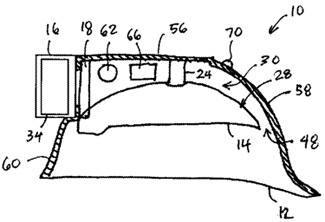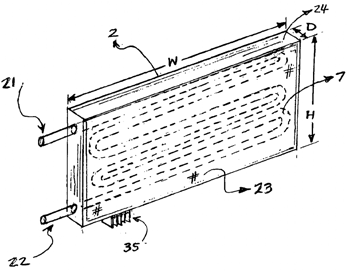 The Phase Change Matters e-mail newsletter is a weekly summary of the latest news and research on phase change materials and thermal energy storage. To subscribe, visit www.puretemp.com/subscribe. For more frequent updates, follow @puretemp on Twitter or visit the Phase Change Matters blog, www.puretemp.com/pcmatters.
The Phase Change Matters e-mail newsletter is a weekly summary of the latest news and research on phase change materials and thermal energy storage. To subscribe, visit www.puretemp.com/subscribe. For more frequent updates, follow @puretemp on Twitter or visit the Phase Change Matters blog, www.puretemp.com/pcmatters.
IN BRIEF
• ESDA-Axiotherm GmbH won two awards in this year’s INNOspace Masters ideas competition. The competition, sponsored by the Space Administration of the German Aerospace Center, honors innovative ideas that address the challenges faced by the space industry. The winners were announced this week in Berlin. ESDA-Axiotherm won the overall prize for the development of a PCM polymer compound for the thermal stabilization of components and systems. The German company also won the OHB Challenge, which honors ready-to-use solutions.
• Noor Abu Dhabi, the world’s largest single-site solar power project with an installed capacity of 1,177 MW, has been successfully commissioned. The project is a joint venture between the government of Abu Dhabi and a consortium comprising Marubeni Corp., Japan, and Jinko Solar Holding, China. Abu Dhabi says the project’s 3.2 million solar panels provide enough power for 90,000 people.
• The Swedish power producer Vattenfall has commissioned an industrial-scale, 0.5 MW/10 MWh, pilot test facility at its Reuter power plant, employing thermal energy storage technology developed by SaltX of Sweden. The technology uses nano-coated salts to store thermal energy.
• Croda International Plc posted a product announcement on its LinkedIn page this week: “CrodaTherm can be incorporated into wearable and non-wearable textile fibres to improve temperature regulation.” There’s more information on crodatherm.com. According to the website, Croda has encapsulated its bio-based phase change material “in a durable acrylic polymer shell, so that when the bio-based core changes phase, the particle remains solid.” I hope to have more details on the technology in time for next week’s newsletter.
PATENTS
Solar shingles with phase change material
U.S. patent application 20190207555 (assignee Hall Labs LLC, Provo, Utah):
“In one aspect, the invention is a system for installing solar shingles on a slanted roof, the system, which includes a roofing underlayment on top of the roof and providing mechanical and electrical connection for solar shingles. The system also includes a plurality of rectangular solar shingles, each shingle with a top edge and a bottom edge. … Each solar shingle may also include a first layer of phase change material on a bottom surface of each solar shingle.”
Hat with forced air cooling
 U.S. patent application 20190191812 (inventors Mohamed Salem, Fresno, Calif., and Mike Sullivan, Scottsdale, Ariz.):
U.S. patent application 20190191812 (inventors Mohamed Salem, Fresno, Calif., and Mike Sullivan, Scottsdale, Ariz.):
“A hat capable of forced air cooling comprises a shell and a liner between which an air passage is formed. A fan forces air through the air passage, the air having been cooled by a phase change material [34] carried on the hat. The liner can have grooves that channel the cooled air above and around the top of the person’s head to ventilation vents at the front of the hat. The hat can have a solar cell for charging a battery and a temperature controller that manages operation of the fan.”
Vehicle charging systems incorporating PCMs
U.S. patent application 20190202302 (applicant Ford Global Technologies, Dearborn, Mich.):
“A charging system for an electrified vehicle includes a charging component and a phase change material positioned relative to the charging component and configured to absorb heat from the charging component. The charging component may include a vehicle inlet assembly, a charge cord, a charge connector, a high voltage cable, etc.”
Room space cooling with improved thermal performance
 U.S. patent application 20190195519 (applicant Twyce Energy Ltd., Boulder, Colo.):
U.S. patent application 20190195519 (applicant Twyce Energy Ltd., Boulder, Colo.):
“A regenerative thermal storage system for cooling a room-space comprising a storage tank [2] holding a phase change material and having an internal cooling coil and having a portion of the tank outer surface located such that within or proximate to the room-space wherein the said outer surface of the storage tank is the principal pathway for heat exchange between the room-space and the phase change material; and a refrigeration cycle unit outside the room-space to provide refrigerant circulation to the said coil for cooling the phase change material; and a control system to operate the said thermal storage system in CHARGING, DISCHARGING and MIXED modes.”
RESEARCH ROUNDUP
For our full list of recent academic research, see puretemp.com/academic. Here are highlights from the past week:
From Chemosphere:• Spent coffee grounds as supporting materials to produce bio-composite PCM with natural waxes
From Biotechnology Reports:
• Novel phase change materials for thermal energy storage: evaluation of tropical tree fruit oils
From Construction and Building Materials:
• Compressive strength and hygric properties of concretes incorporating microencapsulated phase change material
• Thermal enhanced cement-lime mortars with phase change materials (PCM), lightweight aggregate and cellulose fibers
From Case Studies in Thermal Engineering:
• Optimal fin parameters used for enhancing the melting and solidification of phase-change material in a heat exchanger unite
From Materials Chemistry and Physics:
• Porous geopolymer as a possible template for a phase change material
From Journal of Physics: Conference Series:
• Thermophysical Characteristics of VCO-Soybean Oil Mixture as Phase Change Material (PCM) using T-History Method
From Rubber Chemistry and Technology:
• Phase-Change Material: Natural Rubber Composites for Heat Storage Applications
From Powder Technology:
• An enthalpy based discrete thermal modelling framework for particulate systems with phase change materials
From Chemistry Select:
• Carbon Soot/n–carboxylic Acids Composites As Form‐stable Phase Change Materials For Thermal Energy Storage
From International Journal of Heat and Mass Transfer:
• Experimental study of thermo-physical properties and application of paraffin-carbon nanotubes composite phase change materials
• High thermal response rate and super low supercooling degree microencapsulated phase change materials (MEPCM) developed by optimizing shell with various nanoparticles
From Applied Thermal Engineering:
• Design optimization of the phase change material integrated solar receiver: A numerical parametric study
From Solar Energy Materials and Solar Cells:
• Synthesis and characterization of ditetradecyl succinate and dioctadecyl succinate as novel phase change materials for thermal energy storage
From Advanced Materials Interfaces:
• Doubly Coated, Organic–Inorganic Paraffin Phase Change Materials: Zinc Oxide Coating of Hermetically Encapsulated Paraffins
From Journal of Energy Storage:
• Heat transfer enhancement of charging and discharging of phase change materials and size optimization of a latent thermal energy storage system for solar cold storage application
NETWORKING
Connect with PCM experts and industry leaders on LinkedIn
 More than 1,450 people have joined a LinkedIn group devoted to the discussion of phase change material and thermal energy storage. The Phase Change Matters group is an interactive complement to the award-winning blog and newsletter of the same name.
More than 1,450 people have joined a LinkedIn group devoted to the discussion of phase change material and thermal energy storage. The Phase Change Matters group is an interactive complement to the award-winning blog and newsletter of the same name.
You are invited to join the group and connect with PCM and TES experts from around the world. This week we welcome Wouter Vogel, applications scientist at Croda International Plc, Delft, Netherlands.